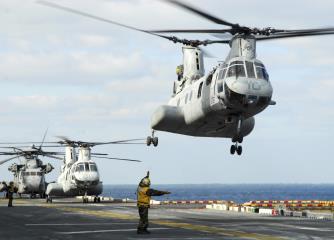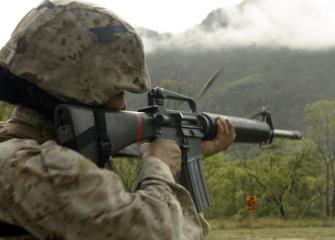What They Do

Members of the U.S. military service maintain the U.S. national defense. Although some service members work in occupations specific to the military, such as fighter pilots or infantrymen, many work in occupations that also exist in the civilian workplace, such as nurses, doctors, and lawyers. Members serve in the Army, Navy, Air Force, Space Force, Marine Corps, or Coast Guard, or in the Reserve components of these branches, and in the Air National Guard and Army National Guard. (The Coast Guard, which is included in this profile, is part of the Department of Homeland Security.)
Duties
The military distinguishes between enlisted and officer careers. Enlisted personnel make up most of the Armed Forces and carry out military operations. The rest are officers—military leaders who manage operations and enlisted personnel. Some officers are warrant officers, who are technical and tactical experts in a specific area. Army aviators, for example, make up one group of warrant officers.
Enlisted personnel typically do the following:
- Participate in, or support, military operations, such as combat or training operations, or humanitarian or disaster relief
- Operate, maintain, and repair equipment
- Perform technical and support activities
- Supervise junior enlisted personnel
Officers typically do the following:
- Plan, organize, and lead troops and activities in military operations
- Manage enlisted personnel
- Operate and command aircraft, ships, or armored vehicles
- Provide medical, legal, engineering, and other services to military personnel
Types of Enlisted Personnel
The following are examples of types of occupations for enlisted personnel:
Administrative personnel maintain information on personnel, equipment, funds, and other military-related activities. They work in support areas, such as finance, accounting, legal affairs, maintenance, supply, and transportation.
Combat specialty personnel train and work in combat units, such as the infantry, artillery, or Special Forces. For example, infantry specialists conduct ground combat operations, armored vehicle specialists operate battle tanks, and seamanship specialists maintain ships. Combat specialty personnel may maneuver against enemy forces and fire artillery, guns, mortars, or missiles to neutralize them. They may also operate various types of combat vehicles, such as amphibious assault vehicles, tanks, or small boats. Members of elite Special Forces teams are trained to perform specialized missions anywhere in the world on a moment’s notice.
Construction personnel build or repair buildings, airfields, bridges, and other structures. They also may operate heavy equipment, such as bulldozers or cranes. They work with engineers and other building specialists as part of military construction teams. Some construction personnel specialize in an area such as plumbing, electrical wiring, or water purification.
Electronic and electrical equipment repair personnel maintain and repair electronic equipment used by the military. Repairers specialize in an area such as aircraft electrical systems, computers, optical equipment, communications, or weapons systems. For example, weapons electronic maintenance technicians maintain and repair electronic components and systems that help locate targets and help aim and fire weapons.
Engineering, science, and technical personnel perform a variety of tasks, such as operating technical equipment, solving problems, and collecting and interpreting information. They perform technical tasks in information technology, environmental health and safety, or intelligence:
- Environmental health and safety specialists inspect military facilities and food supplies to ensure that they are safe for use and consumption.
- Information technology specialists manage and maintain computer and network systems.
- Intelligence specialists gather information and prepare reports for military planning and operations.
Healthcare personnel provide medical services to military personnel and their family members. They may work as part of a patient-service team with doctors, nurses, or other healthcare professionals. Some specialize in providing emergency medical treatment in combat or remote areas. Others specialize in laboratory testing of tissue and blood samples; maintaining pharmacy supplies or patients’ records; assisting with dental procedures; operating diagnostic tools, such as x-ray and ultrasound machines; or other healthcare tasks.
Human resources development personnel recruit qualified people into the military, place them in suitable occupations, and provide training programs:
- Personnel specialists maintain information about military personnel and their training, job assignments, promotions, and health.
- Recruiting specialists provide information about military careers; explain pay, benefits, and military life; and recruit individuals into the military.
- Training specialists and instructors teach military personnel how to perform their jobs.
Machine operator and repair personnel operate industrial equipment and machinery to make and repair parts for a variety of equipment and structures. They may operate engines, nuclear reactors, or water pumps, usually performing a specific job. Welders and metalworkers, for example, work with various types of metals to repair or form the structural parts of ships, buildings, or equipment.
Media and public affairs personnel prepare and present information about military activities to the military and the public.
Protective service personnel enforce military laws and regulations and provide emergency responses to disasters:
- Firefighters prevent and extinguish fires in buildings, on aircraft, and aboard ships.
- Military police responsibilities include controlling traffic, preventing crime, and responding to emergencies.
- Other law enforcement and security specialists investigate crimes committed on military property and guard inmates in military correctional facilities.
Support service personnel provide services that support the morale and well-being of military personnel and their families:
- Food service specialists prepare food in dining halls, hospitals, and ships.
- Religious program specialists assist chaplains with religious services, religious education programs, and related administrative duties.
Transportation and material-handling personnel transport military personnel and cargo. Most personnel within this occupational group are classified according to the mode of transportation, such as aircraft, motor vehicle, or ship:
- Aircrew members operate equipment on aircraft.
- Cargo specialists load and unload military supplies, using forklifts and cranes.
- Quartermasters and boat operators navigate and pilot many types of small watercraft, including tugboats, gunboats, and barges.
- Vehicle drivers operate various military vehicles, including fuel or water tank trucks.
Vehicle and machinery mechanical personnel conduct preventive and corrective maintenance on aircraft, automotive and heavy equipment, and powerhouse station equipment. These workers specialize by the type of equipment that they maintain:
- Aircraft mechanics inspect and service various types of aircraft.
- Automotive and heavy-equipment mechanics maintain and repair vehicles, such as Humvees, trucks, tanks, and other combat vehicles. They also repair bulldozers and other construction equipment.
- Heating and cooling mechanics install and repair air-conditioning, refrigeration, and heating equipment.
- Marine engine mechanics repair and maintain engines on ships, boats, and other watercraft.
- Powerhouse mechanics install, maintain, and repair electrical and mechanical equipment in power-generating stations.
| Enlisted | Army | Air Force | Space Force | Coast Guard | Marine Corps | Navy | Total enlisted personnel in each occupational group |
|---|---|---|---|---|---|---|---|
|
Occupational group |
|||||||
|
Administrative |
4,920 | 13,111 | 3 | — | 11,371 | 20,335 | — |
|
Combat Specialty |
100,183 | 5,141 | 118 | — | 33,562 | 8,911 | — |
|
Construction |
13,916 | 4,879 | 1 | — | 5,658 | 3,718 | — |
|
Electronic and Electrical Equipment Repair |
19,368 | 26,981 | 7 | — | 14,388 | 47,625 | — |
|
Engineering, Science, and Technical |
45,887 | 54,353 | 26 | — | 27,140 | 45,019 | — |
|
Healthcare |
24,499 | 14,282 | 1 | — | — | 22,894 | — |
|
Human Resource Development |
14,625 | 8,350 | 6 | — | 2,374 | 5,347 | — |
|
Machine Operator and Production |
3,811 | 6,466 | 1 | — | 2,289 | 8,405 | — |
|
Media and Public Affairs |
4,843 | 6,495 | 4 | — | 1,376 | 3,485 | — |
|
Protective Service |
19,184 | 33,225 | 11 | — | 4,793 | 13,056 | — |
|
Support Service |
7,487 | 5,447 | 2 | — | 1,798 | 8,988 | — |
|
Transportation and Material Handling |
44,207 | 27,687 | 3 | — | 22,929 | 34,676 | — |
|
Vehicle and Machinery Mechanic |
41,624 | 45,490 | 4 | — | 16,773 | 45,709 | — |
|
Non-occupation or unspecified coded personnel |
5,076 | 811 | 4,390 | — | 664 | 912 | — |
|
Total enlisted personnel for each military branch and Coast Guard |
349,630 | 252,717 | 4,577 | 30,250 | 145,115 | 269,080 | 1,051,369 |
|
SOURCE: U.S. Department of Defense, Defense Manpower Data Center |
|||||||
Types of Officers
The following are examples of types of officers:
Combat specialty officers plan and direct military operations, oversee combat activities, and serve as combat leaders. They may be in charge of tanks and other armored assault vehicles, artillery systems, special operations, or infantry units. This group also includes naval surface warfare and submarine warfare officers, combat pilots, and aircrews.
Engineering, science, and technical officers’ responsibilities depend on their area of expertise. They work in scientific and professional occupations, such as atmospheric scientists, meteorologists, physical scientists, biological scientists, social scientists, attorneys, and other types of scientists or professionals. For example, meteorologists in the military may study the weather to assist in planning flight paths for aircraft.
Executive, administrative, and managerial officers manage administrative functions in the Armed Forces, such as human resources management, training, personnel, information, police, or other support services.
Healthcare officers provide medical services to military personnel in order to maintain or improve their health and physical readiness. Officers such as physicians, physician assistants, nurses, and dentists examine, diagnose, and treat patients. Other healthcare officers provide therapy, rehabilitative treatment, and additional healthcare for patients:
- Dentists treat diseases, disorders, and injuries of the mouth.
- Nurses provide and coordinate patient care in military hospitals and clinics.
- Optometrists treat vision problems and prescribe glasses, contact lenses, or medications.
- Pharmacists purchase, store, and dispense drugs and medicines.
- Physical therapists and occupational therapists plan and administer therapy to help patients adjust to injuries, regain independence, and return to work.
- Physicians, surgeons, and physician assistants examine patients, diagnose injuries and illnesses, and provide treatment to military and their families.
- Psychologists provide mental healthcare and also may conduct research on behavior and emotions.
Human resource development officers manage recruitment, placement, and training programs in the military:
- Personnel managers direct and oversee military personnel functions, such as job assignments, staff promotions, and career counseling.
- Recruiting managers direct and oversee recruiting personnel and recruiting activities.
- Training and education directors identify training needs and develop and manage educational programs.
Media and public affairs officers oversee the development, production, and presentation of information or events for the military and the public. Public affairs officers respond to public inquiries about military activities and prepare news releases.
Protective service officers are responsible for the safety and protection of individuals and property on military bases and vessels. Emergency management officers plan and prepare for all types of disasters. They develop warning, evacuation, and response procedures in preparation for disasters. Law enforcement and security officers enforce all applicable laws on military bases and oversee investigations of crimes.
Support services officers manage military activities in key functional areas, such as logistics, transportation, and supply. They may oversee the transportation and distribution of materials by ground vehicles, aircraft, or ships. They also direct food service facilities and other support activities. Purchasing and contracting managers negotiate and monitor contracts for equipment, supplies, and services that the military buys from the private sector.
Transportation officers manage and perform activities related to the safe transport of military personnel and equipment by air, ground, and water. They operate and command an aircraft or a ship:
- Navigators use radar, radio, and other navigation equipment to determine their position and plan their route of travel.
- Pilots in the military fly various types of military airplanes and helicopters to carry troops and equipment.
- Ships’ engineers direct engineering departments, including engine operations, maintenance, and power generation, aboard ships.
| Officer | Army | Air Force | Space Force | Coast Guard | Marine Corps | Navy | Total officer personnel in each occupational group |
|---|---|---|---|---|---|---|---|
|
Occupational group |
|||||||
|
Combat Specialty |
22,550 | 4,987 | 59 | — | 5,287 | 6,266 | — |
|
Engineering, Science, and Technical |
25,441 | 13,410 | 3,391 | — | 5,133 | 11,241 | — |
|
Executive, Administrative, and Managerial |
13,008 | 6,825 | 938 | — | 3,007 | 6,780 | — |
|
Healthcare |
10,488 | 9,330 | 3 | — | none | 7,223 | — |
|
Human Resource Development |
3,123 | 1,629 | 17 | — | 767 | 3,284 | — |
|
Media and Public Affairs |
420 | 358 | 1 | — | 338 | 281 | — |
|
Protective Service |
2,934 | 1,075 | 1 | — | 347 | 1,215 | — |
|
Support Service |
2,060 | 837 | — | — | 39 | 1,040 | — |
|
Transportation |
10,719 | 21,328 | 12 | — | 6,509 | 9,896 | — |
|
Non-occupation or unspecified coded personnel |
853 | 195 | 17 | — | — | 7,550 | — |
|
Total officer personnel for each military branch and Coast Guard |
91,596 | 59,974 | 4,439 | 8,835 | 21,427 | 54,776 | 241,047 |
|
SOURCE: U.S. Department of Defense, Defense Manpower Data Center |
|||||||
 United States Department of Labor
United States Department of Labor

